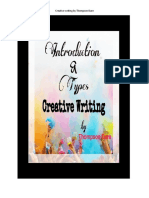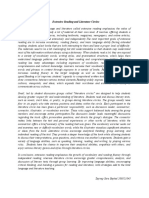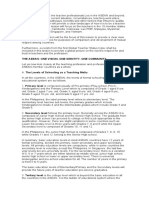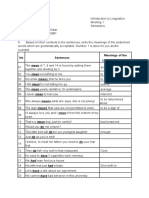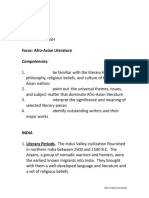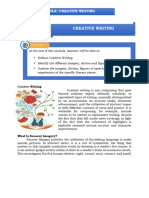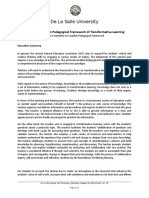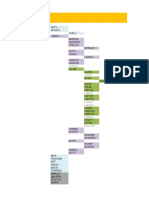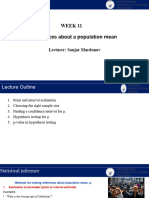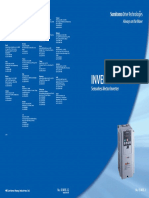0 ratings0% found this document useful (0 votes)
103 viewsAfro Asian Literature
Afro Asian Literature
Uploaded by
Jon Michael Boboyo1. The document provides an overview of the literary traditions of India, Thailand, Indonesia, and China. It discusses major works, genres, and time periods in each tradition.
2. For India, it outlines the Vedas and epics like the Mahabharata and Ramayana as foundational works, and notes dramas, Sanskrit writers, and modern authors.
3. For Thailand, it discusses early inscriptions and genres that developed over time, from the Sukhothai period through the 20th century, noting some influential authors.
Copyright:
© All Rights Reserved
Available Formats
Download as DOCX, PDF, TXT or read online from Scribd
Afro Asian Literature
Afro Asian Literature
Uploaded by
Jon Michael Boboyo0 ratings0% found this document useful (0 votes)
103 views9 pages1. The document provides an overview of the literary traditions of India, Thailand, Indonesia, and China. It discusses major works, genres, and time periods in each tradition.
2. For India, it outlines the Vedas and epics like the Mahabharata and Ramayana as foundational works, and notes dramas, Sanskrit writers, and modern authors.
3. For Thailand, it discusses early inscriptions and genres that developed over time, from the Sukhothai period through the 20th century, noting some influential authors.
Original Title
AFRO-ASIAN-LITERATURE
Copyright
© © All Rights Reserved
Available Formats
DOCX, PDF, TXT or read online from Scribd
Share this document
Did you find this document useful?
Is this content inappropriate?
1. The document provides an overview of the literary traditions of India, Thailand, Indonesia, and China. It discusses major works, genres, and time periods in each tradition.
2. For India, it outlines the Vedas and epics like the Mahabharata and Ramayana as foundational works, and notes dramas, Sanskrit writers, and modern authors.
3. For Thailand, it discusses early inscriptions and genres that developed over time, from the Sukhothai period through the 20th century, noting some influential authors.
Copyright:
© All Rights Reserved
Available Formats
Download as DOCX, PDF, TXT or read online from Scribd
Download as docx, pdf, or txt
0 ratings0% found this document useful (0 votes)
103 views9 pagesAfro Asian Literature
Afro Asian Literature
Uploaded by
Jon Michael Boboyo1. The document provides an overview of the literary traditions of India, Thailand, Indonesia, and China. It discusses major works, genres, and time periods in each tradition.
2. For India, it outlines the Vedas and epics like the Mahabharata and Ramayana as foundational works, and notes dramas, Sanskrit writers, and modern authors.
3. For Thailand, it discusses early inscriptions and genres that developed over time, from the Sukhothai period through the 20th century, noting some influential authors.
Copyright:
© All Rights Reserved
Available Formats
Download as DOCX, PDF, TXT or read online from Scribd
Download as docx, pdf, or txt
You are on page 1of 9
AFRO-ASIAN LITERATURE ◦ Prahsanas—inspired by the lower castes’ ridicule of the upper class
◦ Yatra—inspired by the lewd escapades of the deity Krishna, as told
I. INDIAN LITERATURE by the traveling bards
a. Most literary forms and works in Indian literature incorporate h. Bhavabhuti, Harsha, and Kalidasa were renowned Sanskrit writers.
philosophical and religious concepts. Often, these works are viewed i. Kalidasa wrote Abhijñanashakuntala, or simply Shakuntala. It is a
as extensions of Hindu teachings. play about the love story of Shakuntala and King Dushyanta from
b. Considered to be the oldest Hindu writings, the Vedas (meaning the epic Mahabharata. Sir William Jones translated it to English.
“knowledge” in Sanskrit) are a collection of sacred books written in j. Bhavabhuti was known for his three plays: Mahaviracharita,
Sanskrit. There are four Vedas: Malatimadhava, and Uttararamacharita.
◦ Rig Veda (“knowledge of the verses”)—a collection of 1,028 k. Harsha was an Indian emperor and a poet. He wrote Nā gā nanda,
sacred hymns and is divided into ten books called Mandalas Priyadarśikā , and Ratnā valī.
◦ Yajur Veda (“knowledge of the sacrifice”)—a handbook for priests l. Some of the notable contemporary authors of Indian literature
in the performance of sacrificial rituals include Arundhati Roy and Rabindranath Tagore. Roy was known
◦ Sama Veda (“knowledge of the melodies”)—a collection of chants for her famous novel, The God of Small Things (1997). It won the
and melodies drawn from the Rig Veda and are to be sung during Man Booker Prize for Fiction in 1997. Meanwhile, Tagore was
worship awarded with the Nobel Prize in Literature in 1913. Some of his
◦ Atharva Veda (“knowledge of the fire priest”)—a collection of remarkable works include Mā nasī (1890), Chitrā ṅ gadā (Chitra,
charms, spells, and hymns, largely outside of the scope of worship 1892), and Sonā r Tarī (The Golden Boat, 1894).
and Vedic sacrifice
c. Mahabharata and Ramayana are two great Sanskrit epics in Indian
literature. II. THAI LITERATURE
d. Mahabharata, whose authorship is traditionally attributed to Vyasa, a. The earliest form of Thai literature existed during the Sukhothai
is composed of about one hundred thousand couplets divided into period (from the thirteenth to the fourteenth century). These works
eighteen sections, making it longer than Homer’s Iliad and Odyssey were carved in stones, providing descriptions of how life was back
combined. Mahabharata focuses on the conflict between the Pandava then. The Ram Khamhaeng is distinguished among these stone
and the Kaurava princes. inscriptions, written by King Ram Khamhaeng himself, which is
e. Ramayana, written by the poet Valmiki, contains twenty-four about the economic condition of the kingdom during his rule.
thousand couplets divided into seven books. It centers on the life and b. During the Ayutthaya period (1351−1767), written verses emerged,
adventures of the couple Ramachandra and Sita. focusing on religion, history, and romance, among others. Some
f. The origins of the Indian drama were attributed to the Hindu deities. examples include “Maha chat” (“The Great Birth”), “Lilit Yuan
Brahma, the creator, is believed to have created drama to please the phai” (“The Defeat of the Yuan”), and “Lilit phra Lo” (“The Story of
deities; Shiva, the destroyer, introduced dance; and Vishnu, the Prince Lo”).
preserver, introduced the four types of drama. c. The renaissance of Thai literature began during King Narai’s reign
g. Four types of ancient Indian drama: (1656−1688). The royal court recognized writers, and various
◦ Nataka—inspired by the epics Mahabharata and Ramayana; the writing genres developed, such as nirat poems. These poems focus
highest form of drama on “journeying, separating, and love-longing” (David Smyth,
◦ Prakaranas—inspired by the daily life of mortals, including their Encyclopaedia Britannica). One of the noteworthy works is “Nirat
virtues and weaknesses
1- page / Afro-Asian Literature
khlong kamsuan” (“A Mournful Journey”) by Si Prat, a personal phiphaksa (The Judgment, 1982).
account of the author’s journey into exile.
d. When Thailand recovered from the defeat it suffered from
Myanmar’s Hsinbyushin (1767), significant literary texts were III. INDONESIAN LITERATURE
rewritten, such as Ramakien, Thailand’s national epic based on a. Indonesian literature is composed of oral and written works. Modern
Ramayana; Sunthorn Phu’s Phra Aphai Mani; and Khun Chang Indonesian literature was characterized by works with Western
Khun Phaen, an epic based on amorous and military feats (Smyth, influences, which have emerged in the twentieth century.
Encyclopedia Britannica). b. Prose narratives vary and are influenced by Indian literature and
e. In the twentieth century, translated works of Western texts those of the neighboring countries. They usually focus on “beast
dominated the literary scene (e.g., works of Marie Corelli, Arthur fables,” legends, riddles, adventure stories, and more.
Conan Doyle, Anthony Hope). Series stories surfaced by the mid- c. Texts were written in various languages, chiefly in Javanese and
1920s, chiefly focusing on “rich girl meets poor boy” narratives, or Malay.
vice versa, which usually have a happy ending. d. Early Javanese literature works existed between the ninth and the
f. Notable works such as Akatdamkoeng Raphiphat’s Lakhon haeng tenth century CE. Prose and poems were prevalent, which merely
chiwit (The Circus Life), Siburapha’s Songkhram chiwit (The War served as varieties of the famous Indian epics, Mahabharata and
of Life), and K. Surangkhanang’s Ying khon chua(The Prostitute) Ramayana. Moreover, the Javanese adapted the Sanskrit court poetry
were examples of narratives that tackle social issues, which and developed it as their own.
blossomed e. The onset of Dutch colonization from the eighteenth to the
during the latter part of the 1920s. nineteenth century led to the decrease in Javanese and Malay works.
g. By the 1940s, writers were producing works influenced by social f. The nationalist movement and the development of Bahasa Indonesia
realism. These works commonly reflect social injustice. Meanwhile, as the national language were associated with modern Indonesian
freedom of speech was suppressed from the 1950s to the 1960s, literature.
which was considered as a “dark age” of Thai literature. Escapist g. Some of the modern writers include Muhammad Yamin, Abdul
fiction, one that allows the reader to escape his everyday reality, was Muis, Chairil Anwar, and Pramoedya Ananta Toer.
the only literary genre to have survived. It was also referred to as h. When Suharto rose to power in 1965, the government ordered
“stagnant water literature.” The most successful among these censorship and suspended the freedom of expression in literary
escapist writers was Khamsing Srinawk, who, under the pen name works. The situation of the writers eased when he resigned in 1998.
Lao Kham Hom, wrote the masterpiece, Fa bo kan (The Politician
and Other Stories), which was able to conceal the true nature of the
reality it was trying to portray but managed to deliver a transgressive IV. CHINESE LITERATURE
message. In 1992, the award for National Artist of Thailand was a. literary forms that have emerged during the Tang dynasty (AD 618–
bestowed on Khamsing Srinawk. 960).
h. Social realism was rediscovered in the late 1960s, paving the way for b. Chinese literature, especially poetry, flourished during the Tang
“literature for life.” This movement played a significant role in dynasty.
helping to overthrow the military government in 1973. c. Lüshi (“regulated verse”) was a rigid alternative to gushi. It is
i. Chart Korbjitti proved to be successful among his contemporaries in composed of eight lines with five to seven characters. In addition, it
terms of commercial and artistic accomplishments. His notable follows a certain format: the first two lines should focus on the
works include Chon trork (The End of the Road, 1980) and Kham exposition. As the theme progresses, the structure (body, second, and
2- page / Afro-Asian Literature
third couplets) should be parallel; the conclusion should be apparent White river winding about them;
in the final couplet. (Gushi means “ancient style poetry,” which has a Here we must make separation
lesser metrical limitation and a more extensive rhyme than yuefu; And go out through a thousand miles of dead grass.
yuefu refers to poems based on folk-ballad tradition. The term yuefu
means “music bureau,” which Emperor Wudi established to collect Mind like a floating wide cloud,
songs and their scores “for ceremonial occasions in court.”) Sunset like the parting of old acquaintances Who
d. Jueju (“severed sentence”) is a concise form of lüshi. Instead of eight bow over their clasped hands at a distance. Our
lines, it is composed of a quatrain. It maintains the tonal quality of horses neigh to each others as we are departing.
lüshi but removes either the first or the last four lines. j. Confucian Literature
e. Ci is a song-like poem, or lyric poem, with uneven lengths of lines. It i. Confucian literature was considered as the earliest form of
has rhythmic and tonal patterns that are musical in nature. Ordinary literature, which has existed even before the Qin dynasty.
people were the first to sing a ci, but it was popularized by Some texts were attributed to Confucius himself, while some
professional women singers during the Tang dynasty. Li Yu, the last were regarded as those of his followers. The two most
ruler of Nan, was the greatest among ci poets. important texts of the Confucian literature include the Five
f. Bianwen is a combination of prose and poetry, retelling Buddha’s Classics or Wujing and The Analects. The Analects are a
life. It was believed to be the earliest form of vernacular prose, as collection of sayings and/or teachings of Confucius, his
Buddhist missionaries employed a manner of storytelling using a contemporaries, and followers.
common language that was understood by everyone to channel their 1. The Five Classics contain the norms of Chinese
messages. society.
g. Han Yu led the movement that encouraged writers to look up to ◦ Shijing (“Classic of Poetry”) is the earliest
Zhou philosophers and Han authors as models for writing in prose, collection of poetry, comprising roughly three
instead of complying with the limitations of pianwen(“parallel hundred poems.
prose”). The reform was liberating, leading to a modern style of ◦ Yijing (“Book of Changes”) is an ancient
prose writing wherein writers can freely create texts in various divination text that existed during the Zhou
lengths and patterns. Some important authors of this mode include dynasty. The writers of the Warring States
Liu Zongyan, Shen Yazhi, and Bai Xingjian. (Pianwen is period attempted to explain the world and its
characterized by unconventional structure and balanced but moral principles through the commentaries
nonrhyming patterns. It was generally used in addressing religious found in additional sections of the text.
issues or philosophical arguments.) ◦ Shujing (“Book of Documents”) is a
h. Some of the notable writers during this period include Wang Wei, compilation of the ancient history of China,
Du Fu, and Li Bai. Du Fu’s famous works include “Bingqu xing” whichincludes philosophies and recollections
(“The Ballad of the Army Carts”) and “Liren xing” (“The Beautiful of the great deeds of the rulers.
Woman”). ◦ Liji (“Book of Rites”) is a collection of texts
i. Below are examples of Li Bai’s poems, as translated by the about ethics in rituals, music, education, etc.
celebrated American poet Ezra Pound. Itwas written during the Warring States
period. Dai De and his nephew Dai Sheng
Taking Leave of a Friend compiled the chapters of the texts.
Blue mountains to the north of the walls,
3- page / Afro-Asian Literature
◦ Chunqiu (“Spring and Autumn Annals”) is a Wa ga mi yo ni furu I spent my days in the
chronological history of the state of Lu. It Nagame seshi ma ni world
contains monthly narrations of important —Ono no Komachi And the long rains were
events during the rule of the twelve leaders of falling
Lu. —Translated by Donald Keene
f. Haiku is a traditional Japanese poem that gained recognition during
V. JAPANESE LITERATURE the Edo or Tokugawaperiod (1603–1868). It is a short verse
a. The Kojiki (Records of Ancient Matters) and Nihon shoki composed of three lines with five, seven, and five syllables,
(Chronicles of Japan) comprise the oldest written documents about respectively, making a total of seventeen syllables. Haiku, unlike
the history of Japan. Consisting of three books, Kojiki (completed in conventional Western poetry that focus heavily on rhythm and meter,
AD 712) is a compilation of myths about the origins of the islands of depends on the melodic syllable count and ignores rhyme. Its
Japan, and of the genealogy of the imperial family. Nihon shoki subjects are often about the essence of life, a feeling or an emotion,
(completed in AD 720), a collection of thirty books written in and the beauty of nature. Kigo is an important element of a haiku. It
Chinese, contains the complete existing historical records of Japan, is a word or a phrase that indicates the season a haiku is written.
chronicling the reigns of emperors of Japan from the earliest times to g. Matsuo Bashō (1644–1694), a Japanese poet in the seventeenth
AD 697. century, was consideredthe greatest master of the haiku. Other great
b. The oldest existing anthology of Japanese poetry, Man’yō shū haiku poets include Yosa Buson (1716–1783) and Kobayashi Issa
(Collection of a Myriad Leaves), was produced during the Asuka and (1763–1827).
Nara periods (AD 538–794). Man’yō shū is a collection of more than h. Here are some examples of famous haikus:
4,500 poems, in twenty volumes, written in various forms and furu ike ya The quiet pond
lengths. kawazu tobikomu A frog leaps in,
c. The Kokin Wakashū or Kokinshū (Collection of Ancient and mizu no oto The sound of the water.
Modern Poems), is a collection of 1,111 poems completed in AD —Matsuo Bashō —Translated by Edward
905 during the Heian period (AD 794–1185). Seidensticker
d. Most literary works in the Heian period were dominated by noble
women and their culture. Lady Murasaki Shikibu wrote Genji yuki tokete The snow is melting
monogatari (The Tale of Genji), which was considered to be the mura ippai no and the village is flooded
world’s first novel. Sei Shō nagon, another famous court lady, wrote kodomo kana with children.
the Makura nososhi (The Pillow Book), which was a detailed record —Kobayashi Issa —Translated by
of life at the Japanese imperial court. Robert Hass
e. Tanka (“short song”) is a five-line poem with thirty-one syllables
and follows a 5–7–5–7–7 pattern. Ono no Komachi, one of Japan’s i. Japanese traditional theater is chiefly characterized by movement
greatest female poets of the Heian period, was renowned for her and dance. Two of themost popular forms of traditional Japanese
poems in tanka form. Here is an example: theater are the Noh and the Kabuki.
Hana no iro wa The flowers withered j. Noh
Utsurinikeri na Their color faded away
Itazura ni While meaninglessly
4- page / Afro-Asian Literature
• Noh is the oldest existing form of Japanese theater, having started • The United Nations Educational, Scientific and Cultural
in the fourteenth century. It was a combination of dance, music, and Organization (UNESCO) listed Nôgaku Theater, which covers Noh
drama. and Kyôgen, as one of the Masterpieces of the Oral and Intangible
• It is characterized by the slow movement of the characters, poetic Heritage of Humanity in 2001. (Kyôgen is a comical piece
dialogues, and a monotonous tone. performed during intervals in a Noh play.)
• The main plot varies from legends/mythologies to historical events
to current events.
• Noh characters wear costumes that are heavy, colorful, and have k. Kabuki
intricate details/designs, among others. The main character of the • Kabuki originated in Kyoto. It is a combination of singing,
play, shite, wears a mask. The mask tells the audience what role or dancing, and acting. It is known for the actors’ exaggerated manner
character the shite was trying to portray. Below are the following of presentation.
characters in Noh theater (note that these roles are all portrayed by • The actors wear white makeup with odd details, big and peculiar
men): wigs, and elaborate costumes.
◦ shite—leading character; portrays a demon, deity, spirit, living • The main plot usually includes historical events, conspiracies, and
man, etc. moral issues, among others. Another distinct feature of Kabuki is
◦ waki—supporting character; portrays a samurai, monk, etc. that the characters only perform a part of an entire story. Thus,
◦ hayashi—musicians; provide musical accompaniment for the act members of the audience are encouraged to read about the story first
◦ jiutai—the narrators; assist the shite in narrating the story before watching a show.
◦ koken—stage crew; assist the performers • There were three early variants of Kabuki, namely onna kabuki,
• Zeami Motokiyo, a playwright, popularized Noh during the wakashū kabuki, andyaro kabuki.
Muromachi period (1333−1573). Along with his father, Kan’ami, ◦ onna kabuki (“women’s kabuki”)—It was described as an
they were noted as the founders of Noh theater. erotic performance of the actors,associating it with
• There are six types of Noh plays: prostitution. It was banned in 1629.
◦ kami (“god”)—sacred stories about deities ◦ wakashū kabuki (“young men’s kabuki”)—Young boys
◦ shura mono (“battle play”)—warrior stories replaced women.
◦ katsura mono (“woman play”)—a woman is the central character of In 1652, it was banned due to widespread homosexuality.
the story ◦ yaro kabuki (“male’s kabuki”)—It had an all-male cast.
◦ gendai mono (“present-day play”)—narratives are modern and This variant endures up to thepresent day.
realistic • Actors who play male roles are called tachiyaku, whereas others
◦ kyojo mono (“madwoman play”)—stories involving loss of a child who play female roles arecalled onnagata.
that led to theprotagonist’s insanity • There are three main types of Kabuki theater:
◦ kichiku (“demon”)—features beasts or evil creatures ◦ jidaimono (“historical play”)—It is a play that chiefly
• Some of the notable Noh plays include Kan’ami’s Matsukaze depicts samurai battles. It is usuallyset in a period before the
(Wind in the Pines); Zeami Motokiyo’s Kakyō (The Mirror of the Tokugawa shogunate.
Flower), Sandō (The Three Ways), Takasago, and Izutsu(The Well ◦ sewamono (“domestic play”)—It portrays the life of the
Head); and Komparu Zechiku’s Yō kihi. common people of the Edo period.
• Some of the famous Noh playwrights include Komparu Zenpō , ◦ shosagato (“dance play”)—It refers to the dance-drama
Komparu Zenchiku, andKanze Kojiro Nobumitsu. performed by the onnagata.
5- page / Afro-Asian Literature
• Some of the notable Kabuki plays include Chū shingura (The
Treasury of Loyal Retainers; adapted into film as 47 Ronin);
Okamoto Kidō ’s Banshō Sarayashiki; and Takeda Izumo I, Miyoshi
Shôraku, Takeda Izumo II, and Namiki Sôsuke’s Sugawara denju
tenarai kagami(Sugawara and the Secrets of Calligraphy). VI. AFRICAN LITERATURE
• Some of the famous Kabuki playwrights include Kawatake a. Africa’s traditional literature is oral in nature. Its oral literature
Mokuami and Chikamatsu Monzaemon. includes proverbs, songs, hymns, myths, dramas, and riddles.
• In 2005, UNESCO named the Kabuki Theater as one of the b. Oral literature is dependent on storytellers. According to Harold
Masterpieces of the Oral and Intangible Heritage of Humanity. Scheub, “storytelling is a sensory union of image and idea, a
recreating of the past in terms of the present” (“The nature of
l. Japanese Modern Literature (from 1898 to present) storytelling,” Encyclopaedia Britannica). He added that the
• Some of the notable writers of modern Japanese literature include storyteller uses both realistic and fantasy images to describe the
Mori Ō gai, Natsume Sō seki, Ryū nosuke Akutagawa, Yasunari present life and to embody the culture.
Kawabata, Jun’ichirō Tanizaki, Haruki Murakami, and Ryū c. Riddles
Murakami. • A riddle refers to a confusing question posed as a problem that has
• Former Harvard professor Jay Rubin translated Akutagawa’s to be guessed or answered. Besides its entertainment and social
famous work Rashomon andOther Stories (1915), which was functions, riddles are somehow educational in nature, as they train
published by Penguin in 2006. The 1950 film adaptation ofAkira children to think quickly and logically.
Kurosawa, Rashomon, was based on “Rashomon” and “Yabu no • Like a proverb, a riddle is brief and concise. It also serves as a
naka” (“In a Grove,”1921). The Akutagawa Prize, a tribute to means to say something without explicitly stating it.
Akutagawa, was established in 1935, which was asprestigious as the • Some riddles are composed of a word or a phrase that implies that
Naoki Prize. the answer is based on the sound it produces. See examples below:
• In 1968, Yasunari Kawabata won a Nobel Peace Prize in Literature. ◦ Sengsekede (Answer: “You cannot put a needle on a rock.”)
His famous novel, Yukiguni (Snow Country, 1948), was a striking —The term sengsekederefers to and/or suggests the sound a
collaboration of a haiku and a novel. Below is an excerpt of Snow needle makes when it falls into the ground.
Country. A house was burning while onlookers gathered to watch. ◦ Aa (Answer: “The old man drank a little milk in the dry
What do you think is the significance of the “Milky Way” in this season.”)—The sound that a man produces while quenching
passage? Does it suggest the season of the year? What can you infer his thirst with milk.
with the Milky Way moving in the opposite direction of the smoke? • Sometimes, a riddle is composed of only a word. See examples
below:
The sparks spread off into the Milky Way, and Shimamura was ◦ Invincible (Answer: the wind)
pulled up with them. As the smoke drifted away, the Milky Way ◦ Innumerable (Answer: grass)
seemed to dip and flow in the opposite direction. Occasionally a • There are riddles that do not really “ask” but need a response. Refer
pump missed the roof, and the end of its line of water wavered and to the example below:
turned to a faint white mist, as though lighted by the Milky Way. ◦ Over there smoke goes up, over there smoke goes up.
(Response: “Over there they mourn over a chief, over there
they mourn over a poor man.”)
6- page / Afro-Asian Literature
• A riddle employs various literary devices such as imagery, • Some stories, although they differ in characters, motifs/themes, and
repetition, analogy, onomatopoeia, allusion, and metaphor, among tone, have similar plots. Such is the case with “The Vulture and the
others. Hen” and “The Finch, the Eagle, and the Hen.” Both stories explain
• Other examples of riddles: why birds of prey (i.e., eagle, vulture) snatch chicks from the mother
◦ Always cooked before it’s scraped; always cooked before hen. Long ago, the mother hen owed these birds. They then took her
it’s eaten. (Answer: a fish) chicks as payment. Read the excerpts below:
◦ The little chap who plays the typewriter (Answer: tongue)
◦ Little things that defeat us (Answer: mosquitoes) The Vulture and the Hen
d. Lyric poetry (The excerpt below is from C. Cagnolo’s “Kikuyu tales,” lifted from
• Lyric poetry is the most common form of poetry in sub-Saharan Finnegan’s Oral Literature in Africa.)
Africa. Lyrical poems are characterized by their song-like qualities
such as rhythm and tone. One day the hen thought of borrowing a razor from the
• The reciting or singing of lyrical poems is performed during vulture, to shave the little ones. The shaving was already much
weddings, funerals, and puberty—mostly “rites of passage” overdue, but it couldn’t be helped, because she had no razor, and was
occasions. depending on the kindness of her neighbours. So the hen went to see
• The subjects of lyrical poems vary. These may be animals, people, the vulture and said: ‘Dear vulture, I should like to borrow your
current issues, etc. razor; mine was lost months ago. My little ones are looking very
• Most songs in Africa are antiphonal in form. Antiphonal singing ugly, and also very untidy, with their long unkempt hair overgrown.’
means that two singers, or choirs, are singing alternately. It is The vulture listened to the hen with great concern and, after a
performed by a cantor (“soloist”) and a chorus. The cantor plays an short silence, said: ‘Dear hen, I cannot refuse you this favour.
important role during the performance, as he or she decides when to Tomorrow perhaps I might need your help as well, and we must help
start and end a song. each other. However, you must remember one thing. You know what
• Most song techniques employ a “call and response” pattern. that razor means to me. I have no other income except the rent of
(AFRICA POEM BY DAVID DOPE) that razor; that is to say, that razor is my field, whence I get my daily
food. I do not intend to ask you any fee as I do with others; but
e. Prose please be careful to return it to me, as soon as you have finished your
• Prose narratives center on people, animals, histories, etc. For shaving.’
animal narratives, the plot usually focuses on large animals tricked ‘Thank you, brother vulture, I quite understand what you say,
by smaller ones. Another plot focuses on an attacker (e.g., snake or and I am very grateful to you. I’ll bring it back very soon.’
crocodile) that is trying to deceive its rescuer or savior (e.g., child, The hen was very glad of the favour, and as soon as she
white man, rat) but is instead outsmarted by a third character (e.g., arrived home, made arrangements to be shaved by another woman.
hare, jackal, spider). The third character foils the attacker into a trap. The following morning, she also shaved her two little ones, so that
• Meanwhile, there are also narratives about a hero, portrayed by a the whole family was now shining like the moon. When the work
young boy or an animal, who acquires precious things through trade, was over, instead of immediately returning the razor to the owner,
exchange, and refusal to fight unless his wish was granted (Finnegan, she put it in a leather purse, which was hanging in a corner of the
p. 329). In the end, the hero achieves his utmost desires. In other hut.
versions of this story, there are odd twists, such as the hero losing his The days passed and passed away like the water under the
precious things and starting back at zero. bridge, but the hen never thought again of returning the razor to the
7- page / Afro-Asian Literature
vulture. She forgot it completely. The vulture grew impatient, and ‘Ah! you! What a long time I have spent looking for you.
deeply resented in his heart the unkindness, nay, the ingratitude of Now here you are today. Today you will have to give me back the
the hen. property your family took.’
Pressed by necessity, he decided to go personally to the hen ‘What?’ asked the finch.
and demand his razor. ‘Eagle?’ ‘Yes?’
‘Who told you where I was?’
The Finch, the Eagle, and the Hen ‘The hen.’
(The excerpt below was lifted from Finnegan’s Oral Literature in ‘It was the hen that told you?’
Africa, which she has also recorded.) ‘Yes.’
‘Oh! dear!’ (said the finch) ‘We have both been having
The finch, a small bird, once borrowed money from the trouble then. I—ha! I have been looking for the hen here but could
eagle’s grandfather. He borrowed that money. not find her. And all the time you have been looking for me and
Now the eagle—(he died) leaving his children alone. But he could not find me! Since the hen was the reason you found me, that’s
left a message with them: ‘Your grandfather had money borrowed why I am going to give her to you now.’
from him by the father of the finch.’
Since he (i.e. his family) had lent the money, the (young) f. Proverb
eagle spent a long time looking for the finch. He looked and looked, • A proverb is a popular saying that expresses obvious truths that are
but he could not find him. figurative in nature. It sometimes serves as a reminder or a piece of
One day he went and sat down where they pound the rice. He advice on how people should lead their lives.
was sitting there. When he saw the hen standing there, eating the • A proverb represents abstract ideas through concise and figurative
rice, he asked her: words or phrases. Finnegan remarked, “The literary relevance of
‘Oh, hen.’ these short sayings is clear. Proverbs are a rich source of imagery
‘Yes?’ and succinct expression on which more elaborate forms can draw”
‘What are you doing here?’ (Finnegan, p. 421).
‘I am getting my food’. • There are instances in which a particular term, which is meant to
‘Do you know whereabouts the finch is? He’s the one I’m describe a proverb, encompasses other literary forms. For example,
looking for. He made use of my father’s property. I want him to the term mwambi (from Nyanja) not only refers to a proverb but also
return it .... Do you think refers to a story or a riddle. Olugero (from Ganda) may also mean a
I will be able to find the finch?’ parable or a saying. The term bokolo (from Mongo) covers all poetic
‘Yes, you can find him.’ expressions. Mboro(from Limba) also refers to a riddle or a saying.
‘Well, how can I find him?’ Tindol (from Fulani) may also refer to a moral story.
‘When people get up to go and pound the rice if you go there • Proverbs are used in almost all occasions.
and you hide you will find the finch there.’ • Proverbs convey various meanings. They can come off as a piece
The eagle got there. He went and hid. The finch alighted and of advice, a warning, or an instruction (Finnegan, p. 406). For
began to pick at the ground, searching for his food. The eagle example, the proverb “We watch the bird’s neck while he is talking”
swooped down. has various meanings. According to Finnegan, this proverb could
mean(1) doubting the accuracy of what one is saying; (2) agreeing to
what one will say; and (3) retorting to what one is saying.
8- page / Afro-Asian Literature
• Additionally, in Jabo society, proverbs play an important role
during legal proceedings. The more proverbs a person can employ in
his or her speech, the more effective that person is. Proverbs are also
used to fix an altercation or to iron out a misunderstanding.
g. Modern African Literature
• Some of the famous modern African authors include Chinua
Achebe (Nigerian), Wole Soyinka (Nigerian), and Naguib Mahfouz
(Egyptian).
• Mahfouz is a screenplay writer and a novelist. He was awarded
with the Nobel Prize in Literature in 1988. One of his famous works
was the trilogy Al-Thulā thiyyah (The CairoTrilogy): Bayn al-
qaṣrayn (Palace Walk, 1956), Qaṣr al-shawq (Palace of Desire,
1957), and Al-Sukkariyyah (Sugar Street, 1957). The trilogy focused
on the three generations of various families in Cairo, beginning from
the onset of World War I to the end of the military coup in1952,
which dethroned King Farouk.
• Achebe wrote the famous novel Things Fall Apart (1958). It was
followed by No Longer at Ease (1960), a sequel to his critically
acclaimed novel. He was a recipient of the Man BookerInternational
Prize (2007) and the Dorothy and Lillian Gish Prize (2010).
• Soyinka was a prominent playwright and activist from Nigeria. He
was a recipient of the Nobel Prize in Literature in 1986. Some of his
works include A Dance of the Forests (1963), The Lion and the
Jewel (1963), Jero’s Metamorphosis (1973), and From Zia, with
Love (1992).
9- page / Afro-Asian Literature
You might also like
- Python (Tamil) HandbookDocument21 pagesPython (Tamil) HandbookNirmal Prithivraj MNo ratings yet
- PDFDocument58 pagesPDFAndriy Tretyak100% (2)
- ReviewersDocument8 pagesReviewersAngel Cascayan Delos SantosNo ratings yet
- Creative WritingDocument3 pagesCreative WritingLexi NgNo ratings yet
- Translation and Editing of TextDocument7 pagesTranslation and Editing of Textjonard rodriguezNo ratings yet
- Survey of English and American LiteratureDocument6 pagesSurvey of English and American Literaturecollegeofeducation161No ratings yet
- English and American LiteratureDocument6 pagesEnglish and American LiteratureMarvel FabroNo ratings yet
- GENERAL EDUCATION (Elementary and Secondary) : o o o o o o o o oDocument1 pageGENERAL EDUCATION (Elementary and Secondary) : o o o o o o o o oChristoper HoraNo ratings yet
- Social Dimension of EducationDocument39 pagesSocial Dimension of EducationEvelyn lopezNo ratings yet
- Language and Literature AssessmentDocument6 pagesLanguage and Literature AssessmentPatricia Iris Villafuerte Razon100% (1)
- English and American LiteratureDocument24 pagesEnglish and American LiteratureSardoncillo, Karla MichilleNo ratings yet
- Creative WritingDocument15 pagesCreative WritingThompson DareNo ratings yet
- Language and Literature ArticleDocument2 pagesLanguage and Literature ArticleSare BaykalNo ratings yet
- ED 200 - Social Dimension of Education (CPECT) PDFDocument38 pagesED 200 - Social Dimension of Education (CPECT) PDFkimsaifaNo ratings yet
- Gen. Ed. Reviewer 100 Items With Answer KeyDocument11 pagesGen. Ed. Reviewer 100 Items With Answer KeyexampassnofailphNo ratings yet
- Social Dimension of Education: Einstein S. Azarcon BSED EnglishDocument53 pagesSocial Dimension of Education: Einstein S. Azarcon BSED EnglishTobs AnchetaNo ratings yet
- Social Dimensions of EducationDocument8 pagesSocial Dimensions of EducationLaurice Marie GabianaNo ratings yet
- Creative WritingDocument5 pagesCreative WritingJoemaica CasalioNo ratings yet
- Teaching-ProfessionDocument10 pagesTeaching-ProfessionSheina RabajaNo ratings yet
- Introduction To LinguisticsDocument3 pagesIntroduction To LinguisticsTranslation GoddesNo ratings yet
- Social Dimensions of Education (Castillo, J.)Document15 pagesSocial Dimensions of Education (Castillo, J.)josalyncastillo1No ratings yet
- Afro Asian LiteratureDocument72 pagesAfro Asian LiteraturePrecious AcebucheNo ratings yet
- Teaching and Assessment of Literature StudiesDocument5 pagesTeaching and Assessment of Literature Studiesname lessNo ratings yet
- Mythology and FolkloreDocument3 pagesMythology and FolkloreCristine AspirinNo ratings yet
- Language, Culture and SocietyDocument9 pagesLanguage, Culture and SocietyMichelle BautistaNo ratings yet
- Survey of Philippine Literature in EnglishDocument26 pagesSurvey of Philippine Literature in EnglishJesalie NarteaNo ratings yet
- EL 102 Structure of EnglishDocument1 pageEL 102 Structure of EnglishGeorge Sagun AndresNo ratings yet
- Teaching Profession HandoutDocument6 pagesTeaching Profession Handoutapi-667419633No ratings yet
- English Literature Vs American LiteratureDocument2 pagesEnglish Literature Vs American LiteraturePramod KumarNo ratings yet
- Language and Literary AssessmentDocument3 pagesLanguage and Literary AssessmentGerald TacderasNo ratings yet
- Afro-Asian LiteratureDocument64 pagesAfro-Asian LiteratureShannara Ellise100% (2)
- Principles of TeachingDocument15 pagesPrinciples of TeachingJhunryll HonoridezNo ratings yet
- Listening and ReadingDocument7 pagesListening and ReadingAaqibRNo ratings yet
- Mythology and Folklore Sample SyllabusDocument19 pagesMythology and Folklore Sample SyllabusLarah BautistaNo ratings yet
- Speech and Theater ArtsDocument5 pagesSpeech and Theater ArtsMaria GuimayNo ratings yet
- Introduction To English-American LiteratureDocument2 pagesIntroduction To English-American LiteratureAnjielyn P. RamosNo ratings yet
- Creative WritingDocument18 pagesCreative WritinggermainejustincruzNo ratings yet
- Principles of TeachingDocument4 pagesPrinciples of TeachingRyan Nicolas PastoleroNo ratings yet
- Afro Asian LiteratureDocument125 pagesAfro Asian LiteratureVarie Mae MendozaNo ratings yet
- Gingoog City Colleges, Inc.: College/DepartmentDocument4 pagesGingoog City Colleges, Inc.: College/DepartmentJoevannie AceraNo ratings yet
- Introduction To Social Dimension of EducationDocument18 pagesIntroduction To Social Dimension of EducationKayCee EsmeresNo ratings yet
- World Lit Report Arabian NightsDocument18 pagesWorld Lit Report Arabian NightsRoseAnnNooraNo ratings yet
- Session 2 Structure of EnglishDocument8 pagesSession 2 Structure of EnglishRHEA MARIMLANo ratings yet
- Afro - Asian LiteratureDocument13 pagesAfro - Asian LiteratureAlona UrbiztondoNo ratings yet
- Principles of TeachingDocument16 pagesPrinciples of TeachingLorilee Bernal Diaz DemeterioNo ratings yet
- Stylistics MidtermDocument2 pagesStylistics MidtermWinefredo Quiapo PaghubasanNo ratings yet
- Courseoutline BSED LIT 2Document4 pagesCourseoutline BSED LIT 2Jenn Mendoza SantosNo ratings yet
- Teaching Profession ModuleDocument77 pagesTeaching Profession Modulelucerocatapanggwen.03No ratings yet
- Stylistics and Discourse Analysis Module 6Document15 pagesStylistics and Discourse Analysis Module 6Joshua D. ALARBANo ratings yet
- Module 6 - Making An OutlineDocument6 pagesModule 6 - Making An OutlineSantina MarieNo ratings yet
- Speech and Stage ArtsDocument6 pagesSpeech and Stage ArtsRogelio Jerome CelesteNo ratings yet
- Song of The Jobless GraduateDocument6 pagesSong of The Jobless GraduateAkpevweOghene PeaceNo ratings yet
- Creative WritingDocument3 pagesCreative WritingPanos DalasNo ratings yet
- Learning Contract Subject Code Name Semester / Credit Lecturer Study Program Academic YearDocument4 pagesLearning Contract Subject Code Name Semester / Credit Lecturer Study Program Academic YearElly RahmawatiNo ratings yet
- Midterm Reviewer (Litt 5)Document311 pagesMidterm Reviewer (Litt 5)Balmaceda AdrianeNo ratings yet
- Lasallian Pedagogical FrameworkDocument12 pagesLasallian Pedagogical FrameworkLance Go LlanesNo ratings yet
- Literary Criticism in The PhilippinesDocument9 pagesLiterary Criticism in The PhilippinesMaria Cristina C. MolinaNo ratings yet
- Remedial Instruction in EnglishDocument50 pagesRemedial Instruction in EnglishJean Cleo CanlasNo ratings yet
- The Grammatical Structure of EnglishDocument8 pagesThe Grammatical Structure of Englishsesad35378No ratings yet
- Studies in Language and LiteratureDocument14 pagesStudies in Language and LiteraturejherbozoNo ratings yet
- LET English Major LiteratureDocument42 pagesLET English Major LiteratureJustin Jones NotarteNo ratings yet
- 21st Lit Genre HandoutDocument4 pages21st Lit Genre HandoutJon Michael BoboyoNo ratings yet
- 3 Module 3 - Q1 - GENERAL PHYSICS 1 1Document16 pages3 Module 3 - Q1 - GENERAL PHYSICS 1 1Jon Michael BoboyoNo ratings yet
- Module 11 GAS LAWS1 PDFDocument33 pagesModule 11 GAS LAWS1 PDFJon Michael BoboyoNo ratings yet
- Lesson 1. Introduction To Media and Information LiteracyDocument22 pagesLesson 1. Introduction To Media and Information LiteracyJon Michael BoboyoNo ratings yet
- Lesson1 Week No. 3 Intro To RECREATIONDocument18 pagesLesson1 Week No. 3 Intro To RECREATIONJon Michael BoboyoNo ratings yet
- Biology Notes Alt of Gen Parts 01 - 0307 - 23 1Document12 pagesBiology Notes Alt of Gen Parts 01 - 0307 - 23 1Jon Michael BoboyoNo ratings yet
- CPAR Notes 2Document3 pagesCPAR Notes 2Jon Michael BoboyoNo ratings yet
- 9 Module 9 - Q1 - GENERAL PHYSICS 1Document18 pages9 Module 9 - Q1 - GENERAL PHYSICS 1Jon Michael BoboyoNo ratings yet
- Eps Lab Assignment 4Document1 pageEps Lab Assignment 4Suvasish NathNo ratings yet
- Test Paper Clasa IIIDocument3 pagesTest Paper Clasa IIIAlinaOlteanu100% (1)
- Ielts ExamDocument18 pagesIelts ExammemskhawlaNo ratings yet
- Mini Ethnography Paper Luke Peer RevisionDocument15 pagesMini Ethnography Paper Luke Peer Revisionapi-272551343No ratings yet
- PIC 18 Config BitsDocument4 pagesPIC 18 Config BitsRida100% (1)
- Instant Access to EPISTLES OF THE BRETHREN OF PURITY On Music An Arabic Critical Edition and English Translation of EPISTLE 5 Edited and Translated Owen Wright ebook Full ChaptersDocument40 pagesInstant Access to EPISTLES OF THE BRETHREN OF PURITY On Music An Arabic Critical Edition and English Translation of EPISTLE 5 Edited and Translated Owen Wright ebook Full Chaptersyatesbauta2n100% (6)
- LogDocument4 pagesLogticitici 12No ratings yet
- MTH305Document83 pagesMTH305EmpireFly InternationalNo ratings yet
- EUTRAN Parameters RL70Document122 pagesEUTRAN Parameters RL70BlanMol Arthur50% (4)
- HP Designjet T920 T1500 EPrinter and T2500 T3500 EMultifunction Service ManualDocument477 pagesHP Designjet T920 T1500 EPrinter and T2500 T3500 EMultifunction Service ManualPhil Garbett100% (2)
- Curriculum Vitae Group 5 Finaaal A4Document6 pagesCurriculum Vitae Group 5 Finaaal A4Yassin ZachriahNo ratings yet
- 27.2.12 Lab - Interpret HTTP and DNS Data To Isolate Threat Actor - ILMDocument10 pages27.2.12 Lab - Interpret HTTP and DNS Data To Isolate Threat Actor - ILMKamel Ziani100% (1)
- Chapter 2. Obtaining, Compiling, Installing, and Removing NmapDocument6 pagesChapter 2. Obtaining, Compiling, Installing, and Removing NmapogautierNo ratings yet
- Introducing Twinkl Symbols Into Your ClassroomDocument13 pagesIntroducing Twinkl Symbols Into Your ClassroomNicoleta CirstianNo ratings yet
- Week 11 LectureDocument17 pagesWeek 11 LectureOlana SufiyanNo ratings yet
- The Literary Formofthe QuranDocument10 pagesThe Literary Formofthe QuranTrina CanizoNo ratings yet
- NCERT-Books-for-class 8-English-Honrydew-Chapter 8Document11 pagesNCERT-Books-for-class 8-English-Honrydew-Chapter 8HuskyNo ratings yet
- Embedded Systems: Laboratory ManualDocument32 pagesEmbedded Systems: Laboratory ManualSaman Fatima100% (1)
- SumitomoDocument31 pagesSumitomoXavier Jesus50% (2)
- B.SC - Ist Year TimetableDocument7 pagesB.SC - Ist Year Timetablevedhanthredyy919No ratings yet
- Basic Concept of Process Control SystemDocument29 pagesBasic Concept of Process Control Systemhabtemariam mollaNo ratings yet
- Chuyên Đề 20-Reported Speech-HSDocument9 pagesChuyên Đề 20-Reported Speech-HSNguyễn Anh DũngNo ratings yet
- Philosophy of Education EssayDocument3 pagesPhilosophy of Education Essayapi-548725130No ratings yet
- Lesson Plain in EnglishDocument1 pageLesson Plain in EnglishGrazia PaquiletNo ratings yet
- Sign Language Detection by Abhishek DeshmukhDocument35 pagesSign Language Detection by Abhishek DeshmukhHELLariousNo ratings yet
- Verse An-Naziat From Holy QuranDocument2 pagesVerse An-Naziat From Holy QuranMohammed Abdul Hafeez, B.Com., Hyderabad, IndiaNo ratings yet
- IsiXhosa FAL P2 Nov 2017Document27 pagesIsiXhosa FAL P2 Nov 2017YumnaONo ratings yet
- God's Management PrinciplesDocument35 pagesGod's Management PrinciplesAstrid von OldenburgNo ratings yet











